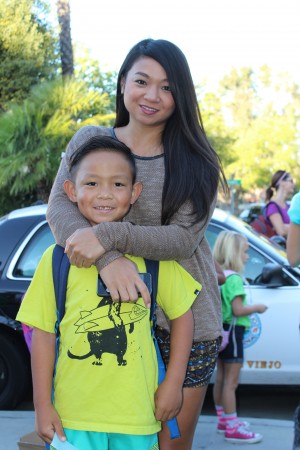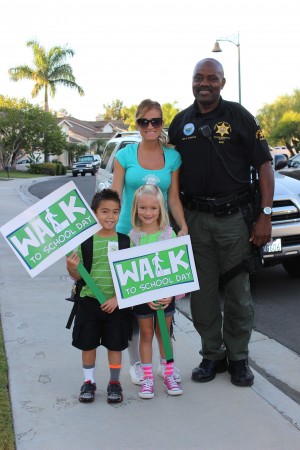Filipinos feel safe walking to school, living in Mission Viejo, California

Bathgate Elementary School kids Marty and Maxi Alegre and Aiden Rodriguez meet up in school. PHOTOS BY CRISTINA PECZON-RODRIGUEZ
MISSION VIEJO, California – Grayson Lapena, six years old, whose grandparents hail from Baguio and Aklan, walks to school each day with his mother, Annette.
The short walk from home gives mother and son a few moments to talk about things like homework from the night before and whom the first-grader will play with during recess that day.
Like many schools across the globe, Bathgate Elementary sees the usual hustle and bustle in the form of a parade of cars for drop off on a daily basis. On October 8, however, traffic was very different. It was Walk to School Day. The school parking lot was virtually empty. Cars driving up to the school was minimal. And despite being a warm sunny day for early October, it couldn’t have been a better day to Walk to School.
Grayson’s school, Bathgate Elementary, participated in the National Walk to School Day, just one of over 4,650 similar events registered this year all over the world to celebrate the campaign. More than 600 of those events are scheduled in California alone.
Three drop-off points were formed, all within half a mile of the Southern California school, for the students to congregate and walk to school as a community for the international event.
Doesn’t feel lost
Grayson has never visited the Philippines, and his mother has only been there twice. But Grayson’s favorite dishes are chicken adobo, pinakbet, sinigang with extra okra. He doesn’t feel lost at Bathgate as a Filipino. There are two other children who are half-Filipino in his First Grade class alone.
This year, Bathgate was awarded the 2014 California Distinguished School Award. This is the second time the elementary school was given this recognition in the program that identifies and honors schools that have demonstrated educational excellence for all students and progress in narrowing the achievement gap.
Having approximately 750 students, covering Pre-school to Grade 5, Bathgate reports that roughly ten percent of the students were declared Asian by their parents – and quite notably – a number of those children have some Filipino heritage.
Jamie and Teresa Alegre were once-upon-a-time high school prom dates at De La Salle Zobel in Metro Manila. After they were reunited many years later, they decided to seek greener pastures in California after they were married. For the Alegre couple, it was an easy and active choice for them as a couple to raise their children in California, despite having grown up themselves in Manila.
All three of their children have gone to Bathgate Elementary. Teresa relates, “We like the intimate and wholesome environment, cultural diversity, the passion and love of the children demonstrated by everyone — from our wonderful Principal Mrs. Kurtz to Mr. Tim, our Property Custodian.”
Excellent school
Their second-generation Filipino children are all physically active, with their eldest son who just graduated from Bathgate excelling in Taekwondo, while his two younger sisters who still attend the elementary school are into swimming and dancing.
Bathgate Elementary, like thousands of other schools across the country today highlighted the importance of physical exercise for growing children. The U.S. Department of Health and Human Services recommends that children and adolescents get at least one hour or more of physical activity each day.
In this day and age of double income families are many times the norm, many children are bring dropped off at school before their parents head to work all over the country.
Heidi Mendoza walked to school today with her six-year-old daughter, Leal. If her schedule permitted her to do so, she and her daughter would talk to school as much as they could. The Mendozas were all smiles this morning as they met with friends and schoolmates for the very popular school event.
The Mission Viejo elementary school enjoys a tight-knit community where on any given day, one is more than likely to see a noteworthy number of families walking to school. The Mission Viejo Blue Ribbon school has a strict school attendance boundary that allows a good number of its students to walk or ride a bike to school.
Half-Filipinos Royce and Rylan Elamparo make their way to school by bike when the weather permits, leaving their bikes near the school playground until class is over. Other children park their razor scooters there and stuff their helmets into their backpacks while they are in school.
Ron Elamparo, father of the two boys, often rides his bike with them en route to school. Ron was born and raised in the US, and has only been to the Philippines a handful of times. His
7-and 6-year-old handsome young boys at Bathgate have yet to visit the country of their paternal grandparents.
One of safest cities
California has the largest Filipino community in the United States and Filipino is the third most common spoken language after English and Spanish. Mission Viejo has been on the list of the safest and most desired cities to reside in across the United States for almost 20 years.
In 2006, Mission Viejo was reported to be the safest city to live in with no reported no murders, the nation’s lowest rape rate, and at the time, third-lowest aggravated assault, violent crime, and property crime rates among cities with populations of 75,000 or more.
Since then, the ranking of Mission Viejo in terms of being a safe community has moved up and down those standards. But it still remains to be a highly desired and safe community to live in.
Second-generation Filipino Ron Elamparo points out the irony in the fact that while Filipinos feel safe here, California standards make it harder for residents to really enjoy that comfort.
Growing up in Los Angeles, Elamparo recalls both walking and biking to school for as long as he can remember when he was little. He wants nothing more than his boys to grow up with the same experience. But because of local laws and standards, his 2nd and 1st grade boys are unable to follow in his footsteps until they are most likely in middle school.
High street safety standards
According to the National Highway Traffic State Administration, not all children are ready to cross the street alone at any one given age. The actual age varies state to state, but in general, children are not considered ready to cross a street alone until they are ten years old.
But children walking and biking to school with their families because of such standards lead clear benefits. They’re not only given a stronger sense of community, they also become closer as a family unit.
On any given day it’s not uncommon for the children and parents alike to continue conversations started the day before with families that take the same route on their way to school. The crossing guards around Bathgate know everyone so well, that if someone isn’t around, they ask for them – many times by name.
Research suggests that emphasizing the importance of regular physical activity at an early age is more likely to encourage children to become healthy, physically active adults.
Additional physical activity
Walking and bicycling to school allows children to add the regular physical activity they need each day while also forming healthy habits that can last a lifetime. Regular physical activity helps children build strong bones, muscles and joints, and it decreases the risk of obesity.
Aiden and Lucas Rodriguez are third-generation Filipinos who have been to Manila every other year since they were born. While they can speak only a handful of Filipino words, they are not shy about teaching the words they do know to their American friends.
Five-year-old Aiden is always talking about how much he loves lumpia and Filipino mangoes and would like nothing more than to bring his best friends back to the Philippines with him one day to visit the country of his grandparents.
In kindergarten, Aiden walks to school every day with his little brother, Lucas, who attends preschool at Bathgate as well. Aiden goes to one-hour training sessions three times a week for the Mission Viejo Nadadores Novice Swim Team and plays soccer in a local league.
So walking to school is hardly the unpleasant experience for him. Walking with his three-year-old brother also means extra brother bonding time as they stop to collect sticks while looking for rolly pollies and rocks.
“I like to walk to school with my brother and friends because we get to take short cuts where a car would never be able to go. It’s like a following a map of a treasure chest! It’s so much FUN!!” Aiden beams, already with a noticeable California accent. The little boys have absolutely no fears when it comes to walking from their home to school.
Kidnap victims
But back in Manila, the extended Rodriguez household conducts its day-to-day life in a different light. In 2009, the youngest brother of their father was kidnapped and held for ransom by AWOL military.
While they are no longer under threat, the lives of the extended Rodriguez family members in the Philippines will never be the same. For years after the kidnapping, the entire Rodriguez family rarely left their house without some sort of a security detail.
But for the young Rodriguez kids who attend Bathgate, walking to school couldn’t be any safer. For the October 8 Walk to School event, local law enforcers came out in full force. The police walked to school with the children, assisted at cross roads and answered questions from the youngsters.
Mission Viejo Mayor Trish Kelley was also on hand to talk about how valuable a healthy lifestyle and the decrease in pollution will be beneficial to the entire community.
All children who participated were given a “character counts” ticket. Such tickets are given as recognition to students when they make good decision, show responsibility, impart kindness and demonstrate a caring attitude that contributes to the unity of the Bathgate School Community. Once a week, during flag assembly, these tickets are drawn to reward students from each grade level.
Walk to School Day brought the entire student body together. Teachers came and joined their students side by side. Even those who lived outside of the “walkable” distance came to join the students from the designated Walk to School Day meeting points.
The kids dressed up in their crazy socks and wore green to support the event as an environmentally safe one. The only wish however remains that this is not something that is done once a year. But one that is done every day by those families that are able to make it possible.
Of course not every family has a schedule that allows for a parent to take a half an hour off for a brisk walk to school with their young ones. But when they do, spending just those few precious moments with their grade school children is an experience that cannot be duplicated in any other way.
Filipinos who live in Southern California may not have the luxuries of household help that their counterparts who reside in the Philippines do. But those that live here are hands on with their children as necessity calls for it. But to these Filipino Bathgate Elementary school parents, it’s a choice they would make time and time again.

